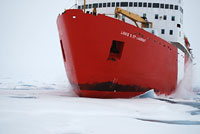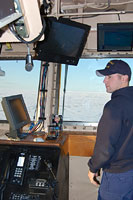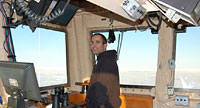

 | |||||||||||||||||||||||||
|
|
Journals 2009/2010Jonathan Pazol
September 1, 2009 People have been asking how ice breakers like the Healy and the Louis actually break ice. In the case of these 2 ships, they work in similar manners - mostly through brute force. No, there are no knife blades or giant corkscrews that come slashing out of the bow. There are also no buzz saws or giant heating coils on the front either. Both of the ships use the shape of their reinforced bows and their immense sizes to cut into the ice and then break it away. The Louis' bow is "sharper" and the beam (width) is narrower than the Healy's. This ship also has bubblers along the sides that help keep the ice away. The Healy is much wider and basically rides up and then "sits" on the ice and pushes it out of the way. It leaves a much cleaner track (path) off the stern.
The Healy is designed to break 1.37 meters (4.5 feet) of ice continuously at 3 knots per hour and 2.44 meters (8 feet) while backing and ramming. According to its operators, it has exceeded this capacity several times. As we're traveling through the ice, the ship sometimes lifts up, lilts to the side, and then moves forward. On the lower decks, you can hear a scraping sound and sometimes even very loud banging, as a large ice chuck bounces around along the hull. The Healy can operate in temperatures as low as -50° F - fortunately, we haven't come close to those temperatures. Boatswains (pronounced "Bosuns") are in charge of operating the ship. They generally do this from the bridge, which encompasses the topmost deck and has 360° view through the windows. While on watch, boatswains are in charge of steering, monitoring the 2 radar systems, communicating with the Louis, keeping the logs, and coordinating any other operations occurring inside or outside on the ship.
In the ice, the ship is controlled from the Aloft Conn, which is 99 feet above the water. From there, the view to the horizon is 11.5 miles on a clear day. Once the control is turned over from the bridge, the Boatswain in the Aloft Conn watches 3 different computer monitors, including one that shows the mapping data from the multi-beam. He or she also controls the speed of the ship, steering, and a great deal of the communication with the engineers, the staff on the bridge, and other personnel. Chief Warrant Officer (CWO) John Rose can often be found on the bridge or the Aloft Conn, running the Healy and training other crew members.
I was very lucky today to "shadow" CWO Rose, and he gave me some "driving" instructions. Yes, folks, for almost 2 hours, I got to drive the Healy from the Aloft Conn through the ice. (Some of you who know my car driving abilities may be appalled). It was an awesome experience. I tried to follow the "Ten Commandments of Ice Breaking" and did pretty well.
When you turn the ship's wheel, there is a lag time before the ship responds. Then, you have to be careful not to let the stern "swing" wide because then the path through the ice that we're clearing is not straight. I learned how to maneuver through ice ridges (and only purposely ran over one really large chunk - isn't that what the ship is for?!?). I even managed to avoid hitting the Louis' helicopter which was flying within 50 yards from the ship. At one point, it even landed less than 200 yards in front of the bow - we were worried about the large crack that opened up just behind it.
For those of you who are worried, we are still afloat, and we didn't spring any leaks. What a cool opportunity! |
||||||||||||||||||||||||






